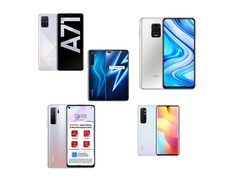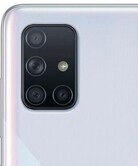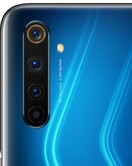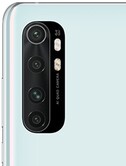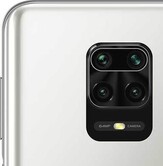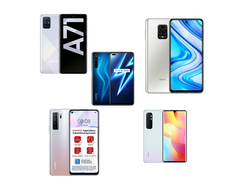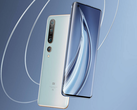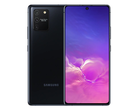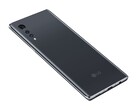Since we have already subjected the best Android cameras to extensive testing, we are now analyzing the current middle class from the Android department. All of our comparison devices rely on a quad-camera setup with a 64 MP main camera as well as an ultra wide-angle camera with a resolution of 8 MP. The only exception is the Galaxy A71, which uses a 12 MP ultra wide-angle lens instead.
By comparing photos taken in various everyday scenes and lighting conditions, we will get a closer look at the differences in photo quality between these mid-range Android phones. But first, a brief summary of the technical specifications of the built-in camera modules for each phone.
Comparison Between Mid-range Smartphone Cameras
The camera quartet of the Samsung Galaxy A71 is based on an in-house-engineered 64 MP wide-angle lens (Isocell Bright GW1), a 12 MP ultra wide-angle lens, a 5 MP depth lens, and a 5 MP macro lens.
Huawei equipped its P40 series mid-range phone with a quad camera setup. The 64 MP main sensor is accompanied by an 8 MP ultra wide-angle lens and two 2 MP sensors for macro and bokeh photography. The Shenzhen-based Chinese manufacturer has not clarified what camera sensors they use.
On the back of the realme 6 Pro, there is a 64 MP main sensor from Samsung (Isocell Bright GW1), an 8 MP strong sensor for ultra wide-angle shots, a 12 MP telephoto lens, and a 2 MP sensor for macro shots.
The Xiaomi Mi Note 10 Lite uses a 64 MP sensor from Sony (IMX 686) for the main camera. In addition to the main camera, the quad-cam setup has an 8 MP wide-angle lens, a 5 MP macro lens, and a 2 MP depth sensor.
The Redmi Note 9 Pro also uses a quad camera module with a 64 MP resolution. In contrast to the Mi Note 10 Lite, though, Xiaomi uses an Isocell Bright GW1 from Samsung for the Redmi model. In addition to the main camera, there is an 8 MP ultra wide-angle camera, a 5 MP macro camera, and a 2 MP depth sensor.
| Samsung Galaxy A71 | Huawei P40 Lite 5G | realme 6 Pro | Xiaomi Mi Note 10 Lite | Redmi Note 9 Pro | |
|---|---|---|---|---|---|
| Rear Camera Setup | Camera 1: 64 MP, 0.8 µm, 1/1.73“; Camera 2: 12 MP.1.12 µm, 1/3.0“; Camera 3: 5 MP, 1.12 µm, 1/5.0“; Camera 4: 5 MP, 1.12 µm, 1/5.0“ | Camera 1: 64 MP, f/1.8; Camera 2: 8 MP, f/2.4; Camera 3: 2 MP, f/2.4; Camera 4: 2 MP, f/2.4 | Camera 1: 64 MP, 26 mm, f/1.8, 1/1.7"; Camera 2: 8 MP, 15.7 mm, 119°, f/2.3; Camera 3: 12 MP, 54 mm, f/2.5; Camera 4: 2 MP, f/2.4 | Camera 1: 64 MP, f/1.89; Camera 2: 8 MP, f/2.4, Camera 3: 5 MP, f/2.4; Camera 4: 2 MP, f/2.4 | Camera 1: 64 MP, f/1.89, 1/1.72", 0.8µm, Camera 2:8 MP, f/2.2, 1/4.0", 1.12µm, Camera 3: 5 MP, f/2.4, 1/5", 1.12µm, Camera 4: 2 MP, f/2.4, 1/5", 1.75µm |
| Front Camera Setup | 32 MP: 0.8 µm, 1/2.74“ | 16 MP, f/2.0 | 16 MP + 8 MP ( 105°, f/2.2) | 16 MP, f/2.48 | 16 MP, f/2.48, 1.0µm |
| Software Version | A715FXXU2ATE8 | 10.1.1.146 | RMX2063_11_A_25 | 11.0.5.0 | 11.0.1.0 |
Rear Camera Pictures
For this comparison, we used the smartphones in their photo, portrait, and night picture modes, which are modes defined in the default photo apps on the phones we tested; these photo apps were installed by the manufacturers of each phone. All shots in this comparison are made with the help of artificial intelligence and HDR in automatic mode. The camera settings are left in their factory settings. We chose a 5x magnification for the zoom shots, but the maximum zoom range of most of our test devices is 10x with the exception of the realme 6 Pro (20x) and Galaxy A71 (8x).
Daylight Photos
The five comparison devices do not have any serious weaknesses in very good lighting conditions. Even under difficult lighting situations, the current mid-range smartphones capture the scenes well, as our photo of the pedestrian tunnel reveals (scene 4). However, the slow release times of the Galaxy A71 compared to the competition are striking - they are noticeably longer.
In our opinion, there is no clear winner in the daylight images; the shots of the Mi Note 10 Lite are a bit too inconsistent for that. Overall, the Xiaomi phone has the best image sharpness, dynamics, and natural color rendering. However, the Mi Note 10 Lite sometimes has problems with sharpness (scene 4). There are also some slight image noise issues in shadowy areas, and colors sometimes appear somewhat dull (fruit bowl). The Redmi Note 9 Pro is on a similar level. The photos are often a little blurred and partially over-sharpened compared to the Xiaomi model. However, there are also shots in our test photo portfolio that appear more appealing with the Redmi smartphone (scene 4).
Clear artifacts also occur with the realme 6 Pro. Its Samsung image sensor struggles with noise in the daylight, so the pictures look very grainy. The exposure is also often poor. That said, the sharpness in the photos is fine.
The Galaxy A71 has a level of quality between the Xiaomi phones and the realme 6 Pro. The color accuracy is sometimes poor, Samsung often oversharpens the scenes, and, as already mentioned, the release times need improvement.
We did not like Huawei's daylight photos much. The colors in the P40 Lite 5G’s photos are too warm, and the dynamics in the photos are very heterogeneous (scene 1 vs. scene 4). The colors in the portrait shots also appear exaggerated and unnatural - especially the yellow and green tones. In terms of sharpness, the P40 Lite 5G is also quite poor.
The pictures taken with the ultra wide-angle lenses show a visibly different overall picture when compared to the pictures taken with the main cameras. Even though the main camera of the Mi Note 10 Lite has exceptional color accuracy, the colors of its ultra wide-angle camera are very unnatural. The sharpness in the photos is visibly lost, especially at the edge of the picture, and they have a little bit of noise. The noise is even more obvious with the Redmi Note 9 Pro, which is the device that shows the greatest loss of photo quality between the main and ultra wide-angle lenses.
The realme 6 Pro has relatively good sharpness, satisfactory color accuracy, and low amounts of noise, but the shots are peppered with image errors (including chromatic aberrations). The P40 Lite 5G also does a decent job, but its sharpness and exposure are sometimes poor.
In our opinion, the wide-angle photos of the Galaxy A71 have the best details and dynamics. The wide-angle optics of the Samsung smartphone also show satisfactory color accuracy, and the sharpness of the image is the most even.
When taking zoomed-in pictures, the question of which mid-range phone delivers the best results is clear. The Huawei P40 Lite 5G has high-contrast photos and the best sharpness. The quality of the zoom photos on the Huawei is decent enough for social media content, which isn’t as true for every other phone’s zoomed-in photos.
The Mi Note 10 Lite and Galaxy A71 have visible weaknesses around sharpness - the latter heavily over-sharpened the scenes. The photos taken with the Redmi Note 9 Pro are similarly sharp, and few details are retrained. The realme 6 Pro, even though it is the only phone with a telephoto lens, is not as good as the P40 Lite 5G, but its sharpness and color accuracy are better than the zoomed-in photos taken by the Redmi phone.
Nighttime Photos
Even though our street scene was well lit by streetlights, the photos we took at dusk are, when compared to the photos taken by high-end smartphones, pretty poor overall. In our low-light scene, Huawei’s P40 Lite 5G was able to flex its muscles, though its photos are still quite poor overall.
The photos it took in our low-light scene have a little less noise than the competition, and the details in its photos are emphasized well. When compared to the Huawei, the photos from the other phones are less clear. The Xiaomi Mi Note 10’s photos were especially disappointing.
With all of the mid-range phones, it’s almost impossible to take usable photos in the dark when using the wide angle lens or zooming. While the Mi Note 10 Lite and Redmi Note 9 Pro produce the worst ultra wide-angle photos, their zoom shots are the most appealing. The ultra wide-angle optics of the Huawei P40 Lite 5G are the least noisy and are relatively sharp, but the photos are still poorly lit and retain few details.
Front Camera Photos
Based on nothing but the camera specifications, the realme model has an edge. The 6 Pro is the only smartphone from our comparison to offer a dual camera setup on the front and the ability to take wide-angle selfies. In terms of sharpness, dynamics, and contrast, the Galaxy A71, Redmi Note 9 Pro, and the realme smartphone are neck-and-neck. The question of which of these phones took the best photos is (probably) a matter of taste. The differences in quality between the P40 Lite 5G and Mi Note 10 Lite are much more striking. Selfies with the Huawei mobile phone seem well lit and also relatively sharp, but they have a color accuracy and exposure that takes some getting used to. It’s also a little worse at picking up details, which is ultimately the biggest problem with the Mi Note 10 Lite.
In low-light conditions, all comparison devices have blurring issues, bad sharpness, and noise. The photos taken by the Galaxy A71 and Note 9 Pro are the highest quality, so they are going to be the best for social media usage, but they are still not very nice to look at.
Conclusion - No Mid-Range Phone Camera Impresses in Every Aspect
In very good lighting conditions, the quality of photos taken by the main camera is good with all five mid-range smartphones - there is no major outlier. However, in our view, the Mi Note 10 Lite and the Redmi Note 9 Pro take the most beautiful photos during the day overall. But there is no dominance like last year with the Google Pixel 3a. The Huawei P40 Lite 5G is a bit weaker overall due to slight deficiencies in color accuracy, sharpness and dynamics.
With the ultra wide-angle lens, both budget phones from Xiaomi do poorly. In our opinion, the wide angle photos taken by the Galaxy A71 have the best details and dynamics. That being said, the Huawei P40 Lite 5G takes the most beautiful zoom shots because the contrast and sharpness of its zoom photos is the best.
There is no perfect mid-range mobile phone camera in 2020, so it is not possible to choose a clear winner this year.
In low-light conditions, the shots of all five smartphones have clear problems with image noise, and the details in the photos are greatly reduced. Users of mid-range smartphones will have to accept these drawbacks in regard to low-light photos. When it comes to quality, the P40 Lite 5G’s low-light photos are better than the competition overall, but even its photos have poor illumination and lose a lot of detail.
If the front camera is used, there are only slight differences in quality between the Galaxy A71, Redmi Note 9 Pro, and the realme 6 Pro - all three test devices achieve good results in daylight. However, they start to have major problems in even slightly poorer lighting conditions.


